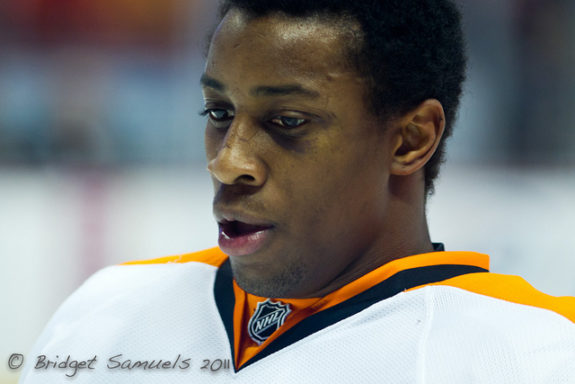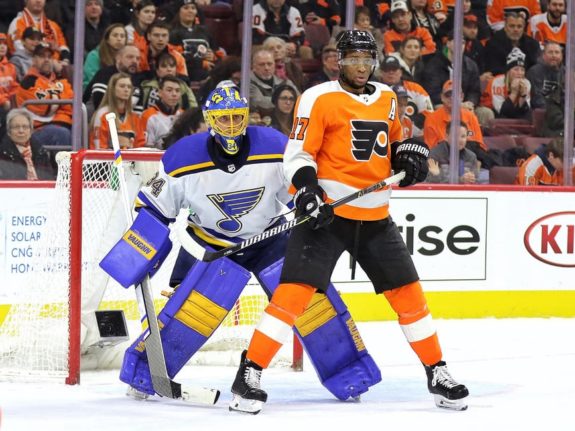![]()
Wayne Simmonds is one of the most-discussed players leading into the NHL’s Monday Trade Deadline. The lanky winger has been a Philadelphia Flyers stalwart for the last eight seasons, but his contract ends this summer. The Flyers’ once-flickering playoff hopes have dimmed after a pair of thumpings this week, quickly vaulting them closer to a sell-off scenario.
While goalscoring has been his forte in the orange and black, his pace has slowed noticeably this season, and his rumored suitors are wondering: “Does this guy still have it?” It’s a valid question. In his previous seven seasons with the Flyers, Simmonds has averaged 29 goals and just under 26 assists. This season, however, he has just 16 goals and 11 assists through 60 games, a 21-goal, 15-assist pace.
Possible Explanations for Simmonds’ Off-Year
Simmonds does play a rough game and though he’s only 30, it may be catching up with him. He’s now played nearly 11 full seasons in the NHL and missed only 24 games. That includes the seven he sat out last season when his eye-popping injury list included a pelvic tear, fractured ankle, pulled groin, torn thumb ligament, and a handful of lost teeth. While he says he “can’t not play,” even when in extreme pain, that mindset could be slowly degrading his game.
On the other hand, the Flyers as a team has been less-than-stellar this season. A bad start, a coaching change, and constantly-shifting lines have hurt Simmonds’ ability to find any regular scoring rhythm. For much of the early season, he found himself on a disjointed unit with James van Riemsdyk, another net-front presence, and Jordan Weal, a replacement-level center.

And the team’s power play, where the big forward has been dynamite for years, has been downright bad. A recent hot streak masks how terrible it has been: before scoring 12 power-play goals in their previous 10 games, the Flyers’ man-advantage unit was converting at below 13 percent through its first 50 games.
It’s the first time in Simmonds’ career with the team that the power play has been below league average. His even strength goal-scoring pace is not far off from what he achieved in many of his 25+ goal seasons, but he’s scoring about half his usual rate on the power play. Of course, whether he’s a victim of a poor power play or the power play is a victim of a poor Simmonds is subject to debate. It’s likely a combination of the two, and neither consideration explains his meager assist production.
Simmonds’ Shortcomings
Even at his best, Simmonds has never been a completely rounded player. His defensive awareness leaves something to be desired, and it’s been seasons since he’s seen any legitimate minutes on the penalty kill – an important consideration for contenders looking to add him to their bottom-six.
His shot from further out from the net is neither bad nor particularly menacing. He’s been part of quite a few great passing plays in his career, but his decision-making with the puck on his stick isn’t quick enough to consider him a real playmaker. And unfortunately, that decision-making seems to be jamming up more often this season.

NHL takeaway/giveaway stats are, unfortunately, too flawed to paint the full picture (he’s a minus-7) but more so than in past seasons, Simmonds has seemed to short out during offensive opportunities. He’s been criticized for waiting too long to make a pass or take a shot before running out of room and either turning the puck over or forcing a pass to a player with just as few options as he had left himself.
It’s difficult to pinpoint, however, if these flaws are getting deeper or if they’re just shining brighter because his scoring is down.
Simmonds at His Best
One rough season does not wipe out a fantastic body of work, nor does it negate Simmonds’ terrific character. He frustrates opponents in so many ways. Most of his goals have come from the very low slot, often on the power play, and he’s made his home as a net-front presence with the hands to pull off a deflection and the spine to take a few dozen crosschecks. He’s not big enough to be immovable, rather, he’s indomitable, he’ll keep coming back. You just can’t deter the guy.
He isn’t a swift player, in terms of edge work or agility, but his straightaway speed is still better than many would assume, given his role and reputation. He can create some separation up the wing or on a breakaway.

Combine that with his known grittiness makes for a player who can be pretty effective on the forecheck when he wants to be, though that’s dependent on the team’s system. When coached by Peter Laviolette, he was able to show a more diligent puck pursuit game than under the Flyers’ more passive recent coaches.
Simmonds, no matter how the rest of his game is going, will always be tough as nails and a superb teammate. Just this week, he took Detroit Red Wing Anthony Mantha to task for a hit Mantha had thrown on Flyers captain Claude Giroux the day before. He’s done that countless times as a Flyer and will continue to do so no matter where he goes.
His fighting isn’t always retaliatory, either: earlier this season, after his team allowed an early goal to their arch-rival Pittsburgh Penguins, Simmonds sensed the moment and dropped the gloves with the much larger Jamie Oleksiak. The bout changed the momentum in the game, which the Flyers went on to win.
Is Wayne Worth It?
With contenders like the Boston Bruins, Nashville Predators, Tampa Bay Lightning, and others supposedly expressing interest in Simmonds, there’s plenty of fans wondering if he’d fit into their team’s plans.
What he likely won’t do is kill penalties or participate in any shutdown scenarios, nor will he be the spark to turn a dud line into a scoring threat. There’s little doubt he has it in him to score goals still, but he will not generate them on his own. Teams interested should have room for him on their power play and have a center to pair him with who can distribute the puck and make space for themselves.

There’s no doubt, however, that Simmonds is an integral teammate and has been throughout his time in the orange and black; he leaves every ounce of his being on the ice. If he goes, he will be dearly missed in the locker room and in the Wells Fargo Center stands. Whether he’ll be similarly embraced by fans in a new home will depend on what he brings on the ice and at what cost.